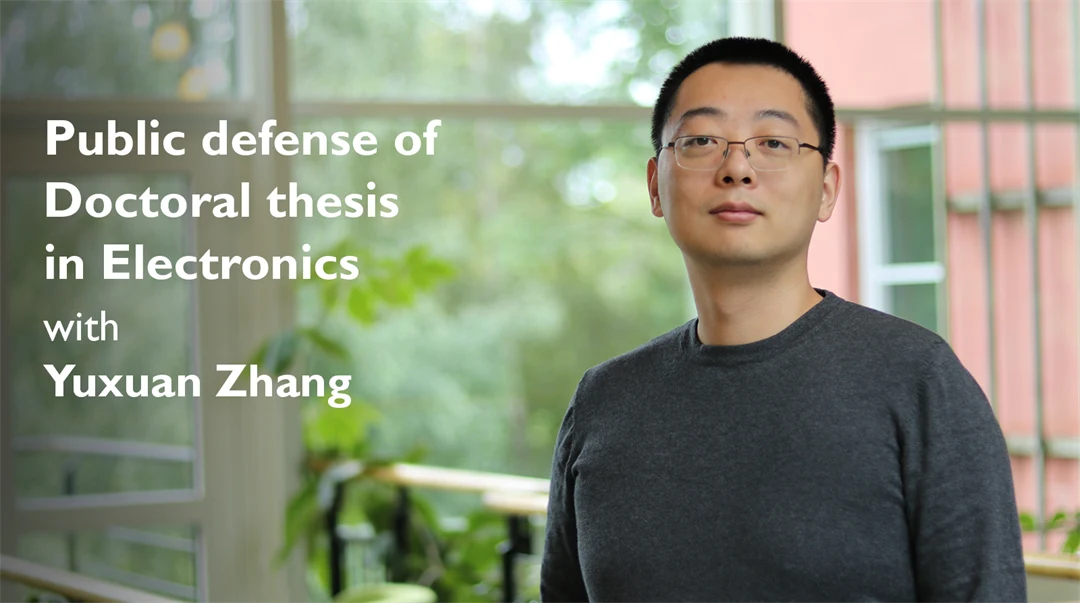Defense of doctoral thesis in Electronics with Yuxuan Zhang
Welcome to a public defense of doctoral thesis in Electronics with Yuxuan Zhang who will present his thesis "Efficient On-Device Intelligence for Structural Health Monitoring: A TinyML Perspective".
Welcome to the public defense of Yuxuan Zhang’s doctoral thesis in Electronics. Yuxuan's work explores how lightweight machine learning and deep learning methods can be designed and optimized for structural health monitoring (SHM) on low-power embedded systems. By focusing on acoustic emission and vision-based damage detection under the TinyML framework, the thesis demonstrates how real-time, energy-efficient monitoring can be achieved directly on devices such as microcontrollers and UAVs, bridging the gap between advanced algorithms and real-world deployment.
More information
Date: September 26, 2025
Time: 09.00
Place: Campus Sundsvall, Room C312, Youtube and Zoom (Meeting ID: 655 9620 4195).
Doctoral thesis: Efficient On-Device Intelligence for Structural Health Monitoring: A TinyML Perspective
Respondent: Yuxuan Zhang
Supervisor and Chair: Associate Prof. Sebastian Bader, Mid Sweden University.
Co-supervisor: Prof. Bengt Oelmann, Mid Sweden University
Opponent/External reviewer: Docent Alessandro Pozzebon, University of Padova, Italien
Examining committee:
Carol Ann Featherston, Cardiff University, United Kingdom
Rishad Shafik, Newcastle University, United Kingdom
Salman Toor, Uppsala University
Backup: Aamir Mahmood, Mid Sweden University
Abstract
Structural Health Monitoring (SHM) plays a pivotal role in ensuring the safety, longevity, and reliability of critical infrastructure. While machine learning (ML) and deep learning (DL) have shown promise in automating SHM tasks, most existing approaches are tailored for high-resource computing platforms and overlook the unique constraints posed by low-power, resource-constrained embedded systems such as microcontrollers (MCUs) and edge devices. This thesis addresses this critical gap by systematically exploring, developing, and optimizing lightweight ML and DL algorithms for efficient on-device intelligence in SHM applications, particularly focusing on acoustic emission (AE)-based and vision-based modalities under the emerging framework of Tiny Machine Learning (TinyML).
The research is organized around three central objectives. First, both lightweight Artificial Neural Networks and Convolutional Neural Networks (CNNs) models are designed and optimized for real-time damage classification using raw AE signals and crack detection tasks using vision data. These models are tailored for deployment on highly resource-constrained MCUs, with particular attention to memory efficiency, inference latency, and energy consumption. Second, the thesis investigates the impact of model complexity and applies a range of model compression techniques such as post-training quantization (PTQ), quantization-aware training (QAT), pruning, and weight clustering. A comprehensive benchmark across various TinyML-compatible toolchains (TensorFlow Lite, STM32Cube.AI, ONNX) evaluates the performance trade-offs of these techniques in real deployment scenarios. Third, recognizing the scarcity of labeled AE data in real-world applications, the research explores both traditional and deep learning-based data augmentation methods, including jittering, warping, and DCGAN-generated synthetic signals, to improve model robustness and generalization.
The study includes extensive empirical evaluations using multiple publicly available AE and image datasets, covering diverse damage types in concrete and composite materials. On the vision side, UAV-based crack detection and segmentation pipelines are implemented using lightweight CNN backbones such as MobileNetV1x0.25 and U-Net variants. These models are trained and validated with various image preprocessing strategies, including grayscale conversion, contrast adjustment, denoising, and morphological operations. A greedy algorithm is also introduced to explore optimal preprocessing combinations. Performance is assessed through metrics such as F1-score, precision, recall, mIoU, model size, inference latency, memory footprint, and per-inference energy consumption, both before and after deployment to embedded devices like OpenMV and STM32 platforms.
The findings demonstrate that, with careful model design, quantization, and data augmentation, it is feasible to achieve high-performance SHM inference directly on-device. Notably, certain models maintained classification accuracies above 90% while reducing energy consumption by more than 60% through compression. For vision tasks, preprocessing pipelines significantly enhanced crack detection accuracy, and deployment on UAV platforms confirmed the viability of real-time aerial inspections with negligible impact on flight time.
In summary, this thesis makes significant contributions to the field of embedded SHM by bridging the gap between algorithmic advances and real-world deployment. It provides a structured pipeline for transitioning from conventional, cloud-centric SHM workflows to fully embedded, energy efficient, and real-time monitoring systems empowered by TinyML. The insights gained herein are expected to inform future developments in both civil infrastructure diagnostics and low-power AI systems.
